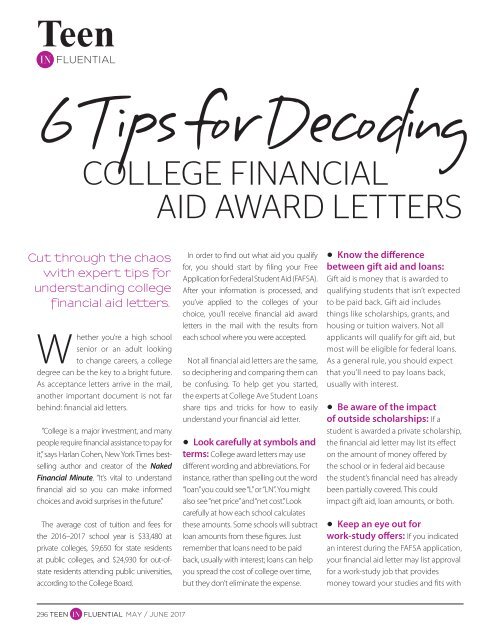InFluential_Magazine_May_June_2017
Create successful ePaper yourself
Turn your PDF publications into a flip-book with our unique Google optimized e-Paper software.
Teen<br />
6 Tips for Decoding<br />
COLLEGE FINANCIAL<br />
AID AWARD LETTERS<br />
Cut through the chaos<br />
with expert tips for<br />
understanding college<br />
financial aid letters.<br />
Whether you’re a high school<br />
senior or an adult looking<br />
to change careers, a college<br />
degree can be the key to a bright future.<br />
As acceptance letters arrive in the mail,<br />
another important document is not far<br />
behind: financial aid letters.<br />
”College is a major investment, and many<br />
people require financial assistance to pay for<br />
it,” says Harlan Cohen, New York Times bestselling<br />
author and creator of the Naked<br />
Financial Minute. “It’s vital to understand<br />
financial aid so you can make informed<br />
choices and avoid surprises in the future.”<br />
The average cost of tuition and fees for<br />
the 2016–<strong>2017</strong> school year is $33,480 at<br />
private colleges, $9,650 for state residents<br />
at public colleges, and $24,930 for out-ofstate<br />
residents attending public universities,<br />
according to the College Board.<br />
In order to find out what aid you qualify<br />
for, you should start by filing your Free<br />
Application for Federal Student Aid (FAFSA).<br />
After your information is processed, and<br />
you’ve applied to the colleges of your<br />
choice, you’ll receive financial aid award<br />
letters in the mail with the results from<br />
each school where you were accepted.<br />
Not all financial aid letters are the same,<br />
so deciphering and comparing them can<br />
be confusing. To help get you started,<br />
the experts at College Ave Student Loans<br />
share tips and tricks for how to easily<br />
understand your financial aid letter.<br />
• Look carefully at symbols and<br />
terms: College award letters may use<br />
different wording and abbreviations. For<br />
instance, rather than spelling out the word<br />
“loan” you could see “L” or “LN”. You might<br />
also see “net price” and “net cost.” Look<br />
carefully at how each school calculates<br />
these amounts. Some schools will subtract<br />
loan amounts from these figures. Just<br />
remember that loans need to be paid<br />
back, usually with interest; loans can help<br />
you spread the cost of college over time,<br />
but they don’t eliminate the expense.<br />
• Know the difference<br />
between gift aid and loans:<br />
Gift aid is money that is awarded to<br />
qualifying students that isn’t expected<br />
to be paid back. Gift aid includes<br />
things like scholarships, grants, and<br />
housing or tuition waivers. Not all<br />
applicants will qualify for gift aid, but<br />
most will be eligible for federal loans.<br />
As a general rule, you should expect<br />
that you’ll need to pay loans back,<br />
usually with interest.<br />
• Be aware of the impact<br />
of outside scholarships: If a<br />
student is awarded a private scholarship,<br />
the financial aid letter may list its effect<br />
on the amount of money offered by<br />
the school or in federal aid because<br />
the student’s financial need has already<br />
been partially covered. This could<br />
impact gift aid, loan amounts, or both.<br />
• Keep an eye out for<br />
work-study offers: If you indicated<br />
an interest during the FAFSA application,<br />
your financial aid letter may list approval<br />
for a work-study job that provides<br />
money toward your studies and fits with<br />
296 TEEN FLUENTIAL MAY / JUNE <strong>2017</strong>


















